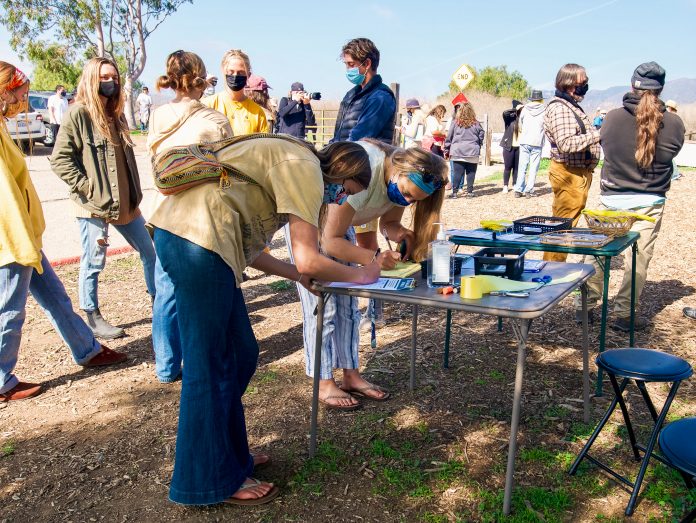Daniela Laborinho Schwartz
Contributing Writer
Last Monday, Save the San Marcos Foothills (SSMF), an advocacy group dedicated to protecting the open space grasslands between Goleta and Santa Barbara, stepped up their efforts to save the land. SSMF held a press release at the entrance to the foothills to share with the public the progress and updates on their efforts such as moving towards legal action.
For months, SSMF has been working hard to fundraise and spread awareness on the issue of developing luxury homes on the native grasslands. Dani Lynch, one of the four founders of SSMF, first found out about the development plans on the San Marcos Foothills a year and a half ago and has been working to protect the land since. The developers, the Chadmar Group, plan to build eight luxury homes on 104 acres of land, according to information on the San Marcos Foothills website. The preserve is a peaceful sanctuary to many, including Lynch. Moreso, these foothills are the county’s last natural preserve, home to many native species, and sacred to the Chumash people, according to Channel Islands Restoration (CIR), a local non-profit that works to protect native county ecosystems.
The press release stated that on top of filing eight appeals on each of the eight proposed luxury homes, SSMF began filing a lawsuit opposing a storage basin being built on what was supposed to be public open space. The SSMF is hoping the county enforces its original decision and protects the land, according to Lynch.
Lynch also emphasized how the open space is a sanctuary to her and many others in the community.
“For me, it has always been my therapy. It is the place where I go to clear my head, just have peace and quiet and also connect to the sacredness of the land because it’s the last of our native grasslands. Even the placements of the boulders and things like that have resonated with me for so long,” Lynch said.
“The event emphasized the importance of this land for all of those in the community as it is crucial to the native flora and fauna as well.”
CIR is another key player that protects the foothills. The non-profit helped SSMF fundraise over $1.4 million so that the land could be bought from the Chadmar group and given to the county of Santa Barbara as public property. However, the developers have not agreed to sell, causing the advocacy group to turn to other strategies like public awareness and legalities.
“We can only pause construction in so many different ways,” Lynch explained. “So right now, one of our action items is having all of our supporters write letters to the developer and the board of supervisors here because if we don’t change their minds, there’s not much we can do,” said Lynch.
Key players in the protection of the foothills spoke at the event and detailed the recent developments, including Ken Owens, director of CIR, Ernestine Ygnacio-De Soto, a Chumash elder, lawyers, and other representatives. Their messages were unanimous: together the community has a chance to overturn the development and protect the land. Over 100 citizens came to the event on Monday to show their support.
“We’ve got enough estates and buildings here in Santa Barbara. This land is sacred and has great meaning, and as I’ve read before, you can hear our ancestors’ voices. You can feel them underneath our feet. This is what we need to be standing in as a free people. And that’s in the community, as well as the Chumash,” said Ygnacio-De Sota at the event.
“Because the land is private, it is not easy to stop development, despite there being significant cultural artifacts and native species. It has not been easy for the environmentalists involved in this fight, however progress has been made.”
The event emphasized the importance of this land for all of those in the community as it is crucial to the native flora and fauna as well. These native plants, like the Santa Barbara Honeysuckle, Golden Yarrow, purple needlegrass, and others, play an important role in supporting the native birds and animals. Burrowing owls, white-tailed kites, raptors, grasshopper sparrows, and other native animals rely on the plants and the preserve for their survival.
“It’s predicted [the native species] will disappear if the development happens because of the degradation from each home’s site,” Lynch said. “They think, ‘oh well it’s only 8 homes.’ But that will have a huge ecological impact. The footprint will shift dramatically, the ecosystem will shift — it’s a ripple effect.”
Because the land is private, it is not easy to stop development, despite there being significant cultural artifacts and native species. It has not been easy for the environmentalists involved in this fight, however progress has been made.
“I’m a big proponent of keeping public land public, not privatized. Although it did happen a really long time ago and we can’t change that now,” Lynch noted. “I think it’s important to mention that we have to protect and preserve what’s left, otherwise who will?” To help save the San Marcos Foothills Preserves, community members can stay informed and take action to show their support. Signing petitions, volunteering, donating, writing letters, and showing up to community events are ways in which SSMF recommends getting involved. Their website, savethesanmarcosfoothills.org, offers plenty of resources and information, along with their Instagram account, @savethesanmarcosfoothills.











